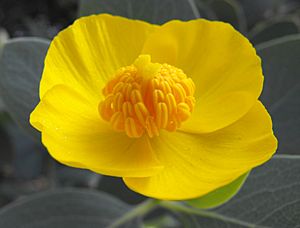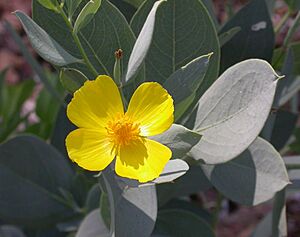Channel Islands tree poppy facts for kids
Quick facts for kids Channel Islands tree poppy |
|
|---|---|
 |
|
| Scientific classification | |
| Genus: |
Dendromecon
|
| Species: |
harfordii
|
| Synonyms | |
|
Dendromecon rigida subsp. harfordii |
|
The Channel Islands tree poppy, also called Harford's tree poppy, is a special flowering plant. Its scientific name is Dendromecon harfordii. This plant belongs to the poppy family, just like the poppies you might see in fields.
It used to be considered a type of another plant called Dendromecon rigida. Back then, its full scientific name was Dendromecon rigida subsp. harfordii.
Where Does the Tree Poppy Grow?
This tree poppy is a unique plant found only in a few places. It grows naturally on some of the Channel Islands of California. These islands include San Clemente Island, Santa Catalina Island, Santa Cruz Island, and Santa Rosa Island.
You can find it living in the California coastal sage and chaparral areas on these islands. These habitats are special places with specific types of plants and weather.
What Does the Tree Poppy Look Like?
The Channel Islands tree poppy is usually a shrub, which is a bushy plant. Sometimes, it can even grow into a small tree! It can reach heights of about 2 to 6 meters (6 to 20 feet) tall.
It has thin branches and oval-shaped leaves. These leaves are smooth and can be 3 to 8 centimeters (about 1 to 3 inches) long. They don't cover the branches very thickly.
When it blooms, it has beautiful, bright yellow flowers. Each flower has four petals that are about 2 or 3 centimeters (less than an inch) long. After the flower, it grows a curved, tube-shaped fruit. This fruit can be over 7 centimeters (almost 3 inches) long.
Why Do People Grow This Plant?
People often grow Dendromecon harfordii as an ornamental plant. This means it's grown because it looks pretty and adds beauty to gardens. It's a great choice for several reasons:
- Native plant gardens: It's perfect for gardens that feature plants naturally found in the area.
- Drought-tolerant gardens: This poppy doesn't need much water, making it good for drought-tolerant gardens.
- Wildlife gardens: It can help attract and support local wildlife.
- Natural landscaping: It fits well into designs that try to look like natural landscapes.


